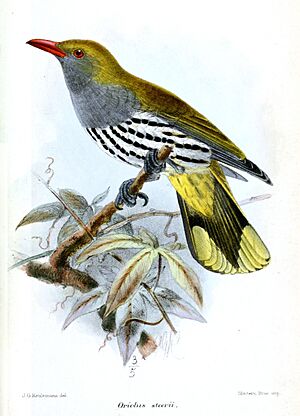Philippine oriole facts for kids
Quick facts for kids Philippine oriole |
|
|---|---|
 |
|
| Conservation status | |
| Scientific classification | |
| Genus: |
Oriolus
|
| Species: |
steerii
|
| Synonyms | |
|
|
The Philippine oriole (Oriolus steerii) is a beautiful bird also known as the grey-throated oriole. It belongs to the Oriolidae family, which includes many types of orioles. This special bird lives only in the Philippines, meaning it is endemic to these islands.
You can find the Philippine oriole in warm, wet lowland forests. It likes places with lots of trees and plants. While this bird is generally common, one specific type, the Cebu oriole (O. s. assimilis), has not been seen since 1906. Sadly, it is now considered extinct, meaning it no longer exists.
About the Philippine Oriole
The Philippine oriole is a striking bird. It has feathers that are mostly yellowish-brown on its upper body. Its beak is a bright red, and its eyes are also red, which makes it stand out.
Where They Live and What They Eat
These orioles live only in the Philippines. They can be found in forests, at the edges of forests, and in areas where new trees are growing. They prefer the lowlands on islands like Masbate, Samar, Leyte, Negros, Bohol, Mindanao, Basilan, and the Sulu Archipelago.
Like many other orioles, the Philippine oriole enjoys a diet that mainly includes grass and flowers. They also eat other similar plant-based foods found in their forest homes.
Different Kinds of Philippine Orioles
Scientists group living things into categories. This helps us understand how they are related. The Philippine oriole was first described by a scientist named Richard Bowdler Sharpe in 1877. It is part of the Oriolus group of birds.
There are five different types, or subspecies, of the Philippine oriole:
- O. s. samarensis: You can find this type on the islands of Samar, Leyte, Bohol, and eastern Mindanao.
- †Cebu dark-throated oriole (O. s. assimilis): This type used to live on Cebu island. Sadly, it is now extinct.
- O. s. steerii: This type lives on Masbate and Negros islands.
- O. s. basilanicus: This type is found on Basilan and western Mindanao.
- O. s. cinereogenys: This type lives in the Sulu Archipelago.


